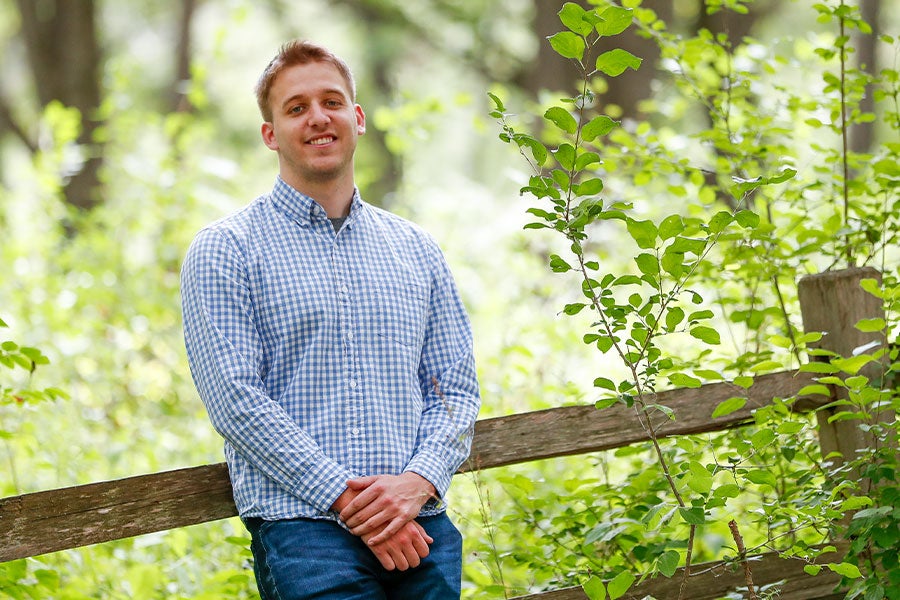When a Sick Deer Looks Healthy
When Cory Anderson ’16 took a course at Luther that asked him to look at the West African Ebola outbreak, he says, “It was the first time I was absolutely fascinated by an assignment. I was reading more than I had to, looking into it more than I had to. It showed me that having an understanding of a virus is important, but there’s a bigger picture at play as far as trying to control a disease. It involves cultural and social communication, as well as politics. That assignment really set me on the path I’m on now.”

That path includes earning a PhD at the University of Minnesota’s School of Public Health and now co-directing the Chronic Wasting Disease (CWD) Program at the Center for Infectious Disease Research and Policy (CIDRAP) under Mike Osterholm ’75.
A Powerful Mentor
Cory remembers hearing about Mike at Luther and thinking, “This guy’s the coolest person in the world, but there’s zero chance I’ll ever work with him.” When Cory chose to focus his research on CWD, however, it piqued Mike’s interest, and Mike became a mentor. The COVID-19 pandemic put the two into closer orbit, and when the pandemic settled down, Cory refocused on CWD, now as co-director of CIDRAP’s program on it.
COVID was an eye-opening experience for a budding epidemiologist. “It was a huge reality check on how people might perceive information,” Cory says. “I think I went in a little bright-eyed and bushy-tailed, and it handed me a lot of reality checks.”
A Tricky Disease
Those reality checks play a role in working to manage the spread of CWD, an infectious neurological disease that affects cervids (deer, elk, and moose). CWD was first detected in the 1960s at a research facility. In the early 1980s, it was discovered in the wild in Wyoming and Colorado. Today, it’s in 36 U.S. states, five Canadian provinces, Scandinavia, and South Korea. Near the town of 1,500 where Cory grew up in southwestern Wisconsin, 40–50 percent of the male deer population is CWD-positive.
There’s no cure for CWD, and it’s always fatal. It’s a prion disease—meaning it’s spread by an infectious protein rather than a virus or bacteria—and when infectious prions are shed into the environment through body fluids, they can persist for years, if not decades, and remain infectious. (There’s no current evidence that CWD can infect humans, but other prion diseases—like BSE, or “mad cow” disease—have been shown to do so.)
Controlling the spread of CWD relies heavily on hunters following the recommendations of wildlife agencies to test deer they kill, dispose of infected deer carefully, avoid transporting infected deer, and more. But it’s an uphill battle. “It can take a year-plus for an animal to show clinical signs of the disease after they become infected,” Cory explains. “So the vast majority of CWD-positive deer that are harvested don’t appear clinically ill, but they’re still infectious.” And when a deer appears healthy, Cory says, a hunter may not test the deer, or they may test it and get a positive CWD result, which causes suspicion and mistrust. “Everything about it is difficult from a disease-management standpoint,” Cory says.
A Path Forward
Cory points out that what’s at risk is not just cervid health—or possibly human health or agriculture—but also wildlife conservation funding. Many wildlife agencies identify CWD as the biggest threat to natural resource conservation because most funding for that work comes through the sale of hunting licenses. And most hunting licenses sold in the U.S.—in Iowa, in Minnesota, in Wisconsin—are for deer. Deer population decline from CWD, or a decline in deer hunting if CWD became a definitive risk to humans or livestock, would put this revenue stream—and larger conservation efforts—at risk.
As co-director of the CWD Program, Cory started initiating necessary conversations that hadn’t yet happened. His team at CIDRAP convened working groups, and together they drafted a gap analysis: What do we know and not know about CWD? How do we prepare for its continued spread? For the possibility of its spreading to domesticated (agricultural) animals? For the possibility of its jumping to humans?
Now, as someone on the front lines of this disease, Cory is working to get accurate, accessible information into the hands of hunters and to lay out a roadmap for what lies ahead.
Help stop the spread of CWD
- Learn whether CWD is present where you hunt.
- If it is and you harvest a deer, get that deer tested. Doing so provides valuable information to wildlife agencies and allows you to make informed decisions about what to do with the animal.
- If the deer tests positive for CWD—even if it appears healthy—consider that other prion diseases (like BSE, or “mad cow” disease) have been shown to infect humans. The CDC and WHO recommend NOT eating meat from CWD-infected animals.